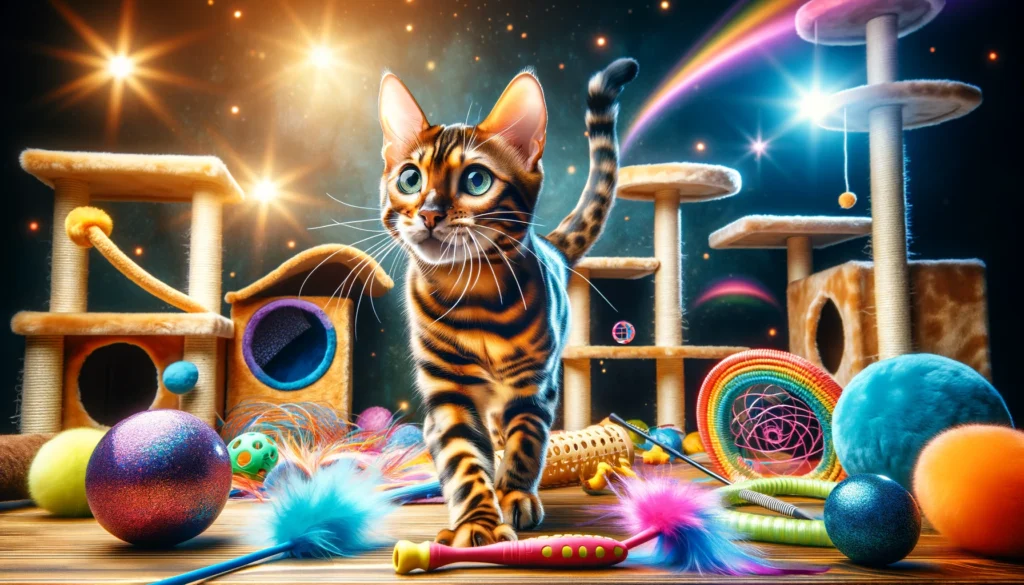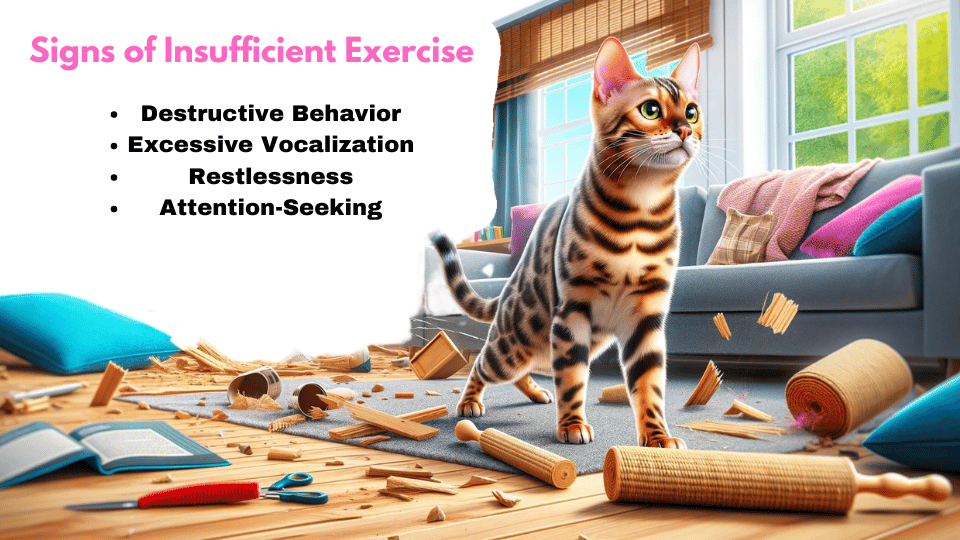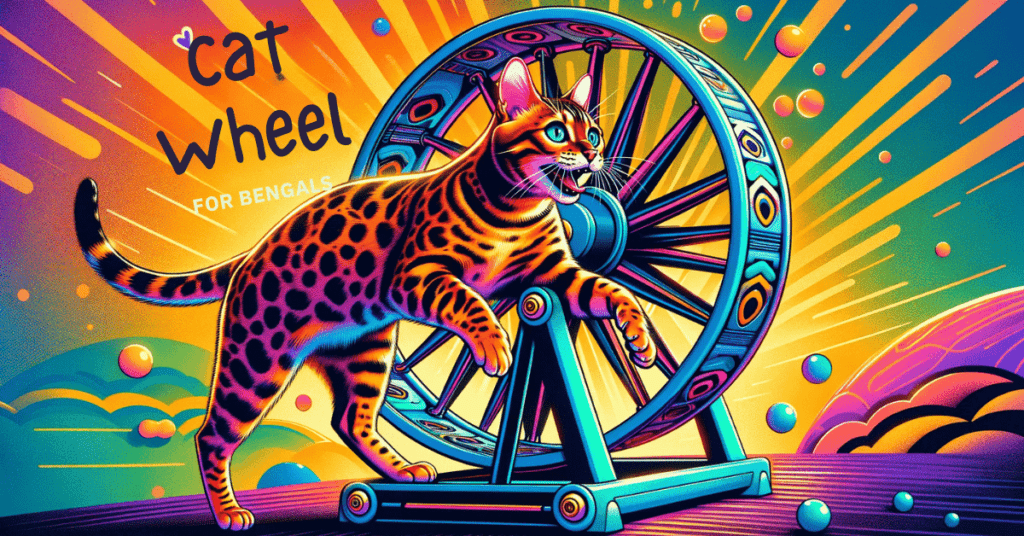This post contains affiliate links and I will be compensated if you make a purchase after clicking on my links.
The Unique Exercise Needs of Bengal Cats
When it comes to Bengal cats, one size doesn’t fit all. You might come across various recommendations on the internet about their exercise needs, but here’s the catch: each Bengal is unique. While all Bengals are high-energy, factors like age, spaying/neutering, and individual energy levels mean that their exercise requirements can vary.
In this post, we will explore Bengal cats exercise requirements and ways to find the ideal playtime and exercise routines to keep your Bengal happy and healthy (and not bored).
Why Bengal Cats Need So Much Exercise?
Bengal cats are renowned for their striking appearance and lively personalities. Descended from the Asian leopard cat, they have a wild streak that shows in both their looks and behavior. Their sleek, muscular bodies and distinctive coat patterns make them stand out, but it’s their energy and curiosity that truly define them.
Bengals are natural athletes, built for speed and agility, capable of jumping up to three times their height. This means you can often find them in the oddest of places. Their high energy level means they need plenty of physical and mental stimulation to prevent unwanted behavior or aggression.
Bengal Cats Exercise Requirements

A general rule of thumb for Bengal cats is to aim for at least 1 hour of exercise daily, though this can vary depending on their age, energy levels, and individual personality.
This hour should be divided into various activities to keep your Bengal engaged and stimulated, including interactive play with you, interactions with other pets (cats or even dogs), and solo playtime with toys and climbing structures.
For some super energetic and young Bengals, this 1 hour can extend up to 2 or even 3 hours, especially since younger Bengals tend to sleep less and have more energy to burn.
Recognizing Signs of Insufficient Exercise

It’s essential to observe your Bengal’s behavior to ensure they are getting enough exercise. Signs of insufficient exercise include:
- Destructive Behavior: Scratching furniture, chewing on items, or knocking things over.
- Excessive Vocalization: Constant meowing or yowling, especially at night.
- Restlessness: Pacing, hyperactivity, or inability to settle down.
- Attention-Seeking: Mischievous actions to get your attention, such as knocking items off counters or repeatedly interrupting you.
If you notice any of these bad behaviors, it’s a sign that your Bengal needs more physical and mental stimulation.
Creating an Effective Exercise Routine

Absolute Minimum Exercise Plan
Even on your busiest days, it’s crucial to ensure your Bengal gets some form of exercise. Here’s the absolute minimum plan:
- Interactive Play (15-20 minutes): Spend at least 15-20 minutes playing directly with your Bengal cat. Use toys like feather wands, laser pointers, or interactive puzzle toys.
- Solo Play and Enrichment (40 minutes): Provide ample toys, climbing structures, and cat wheels for your Bengal to use while you’re away. This helps them reach the absolute minimum exercise requirement.
Enhanced Exercise Plan
If the minimum exercise plan isn’t enough to curb your Bengal’s energy, consider an enhanced routine:
- Incorporate Two Playtime Sessions: Engage your Bengal in two play sessions of 15-30 minutes each—one in the morning and one in the evening. This helps burn off energy throughout the day and reduces restlessness at night.
- Stimulating Environment (60 minutes): Provide a variety of toys, climbing structures, and cat wheels to keep them engaged throughout the day. This helps prevent boredom and allows them to expend their energy constructively.
Types of Exercise for Bengal Cats
Bengal cats are intelligent felines that need variety, just like us humans, to prevent boredom and keep things exciting for both of you. Here are some great ways to keep your Bengal cat engaged:
- Interactive Play: Bengal cats thrive on interactive play. Use toys like laser pointers and feather wands to provide both physical and mental stimulation. It’s a fun way for you to bond and challenge your Bengal’s mind.
- Climbing and Jumping: Bengals love to climb and jump. Provide cat trees, shelves, and other climbing structures to satisfy their natural instincts. A big cat tree is perfect for them to explore and exercise their muscles.
- Hunting Simulations: Toys that mimic prey, such as robotic mice or feather toys, can engage your Bengal’s hunting instincts. These toys provide great exercise and mental stimulation as they pounce and chase.
- Social Interaction: Playtime with humans and other pets is essential. Bengals enjoy the companionship and the opportunity to engage in playful activities. Consider a playmate for your Bengal, whether it’s another cat or even a friendly dog.
- Leash Adventures: While taking your Bengal out on a leash can be risky if there are dogs around, finding a quiet place for leash walks can be a thrilling experience for them. They love exploring new environments safely.
- Swimming: Some Bengals enjoy water. If your cat is one of them, supervised swimming can be a unique and enjoyable form of exercise.
- Cat Wheels: A cat exercise wheel can be a great investment. It allows them to run to their heart’s content indoors.
Monitoring Your Bengal Cat’s Health
Regular exercise is crucial for maintaining a healthy weight in Bengal cats, helping to prevent obesity and related health issues. Beyond physical health, exercise is essential for mental well-being, reducing anxiety, and preventing behavioral problems. A mentally stimulated Bengal is a happy Bengal.
Additionally, regular veterinary check-ups are vital. These visits ensure your Bengal remains healthy and can help catch potential issues early, complementing the exercise routine you establish at home.
Common Challenges and Solutions
We all have busy schedules, and Bengal cats are the type of cats that need interaction and attention. Many people might not have time for play sessions in the morning, especially if you’re rushing to work or handling other chores. However, it’s essential to make time for them. Bengal cats have flexible schedules, and you can adjust playtime to other parts of the day—they will still love it.
If you’re short on time, consider automated toys, which provide interactive play even when you’re not home. Hiring a pet sitter is another option to keep your Bengal engaged and active.
Pro Tip: A great solution is to get two Bengals instead of one, ideally siblings so they get along well. They will tire each other out and keep each other entertained, reducing the amount of work for you.
Ensuring Your Bengal Cat’s Happiness and Health
Understanding and meeting Bengal Cats Exercise Requirements is essential for their well-being. Compared to more laid-back cats such as Ragdolls or Persians, Bengal cats are more high-maintenance and demand more interaction and stimulation.
It really depends on your personality and lifestyle. If you’re looking for a lap cat and can’t dedicate time to play with them daily—which is also a great opportunity to bond—then a Bengal might not be the right choice for you. However, if you can provide regular, varied, and engaging exercise opportunities, you can ensure that your Bengal stays happy, healthy, and well-behaved.
Meet Sean, a fintech whiz with a penchant for pet purrs and blockchain buzz. After a decade of fintech feats, Sean’s tech talents leaped from ledger lines to litter lines, driven by a passion for pets and a vision for a more connected pet care community. With three critter companions as co-pilots, Sean launched this blog to share a treasury of pet-friendly tech tips and tales.






